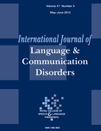
INTERNATIONAL JOURNAL OF LANGUAGE & COMMUNICATION DISORDERS
Scope & Guideline
Exploring the Complexities of Communication Disorders
Introduction
Aims and Scopes
- Assessment and Diagnosis:
The journal emphasizes research on assessment tools and diagnostic criteria for various communication disorders, including speech sound disorders, dysphagia, and aphasia. This includes studies validating new assessment instruments and exploring existing diagnostic practices. - Intervention Strategies:
A core focus of the journal is on effective intervention strategies for individuals with communication disorders. This includes systematic reviews, randomized controlled trials, and qualitative studies investigating the efficacy of different therapeutic approaches. - Multidisciplinary Approaches:
The journal promotes interdisciplinary research that involves collaboration among speech-language therapists, psychologists, educators, and other health professionals to address the complex needs of individuals with language and communication disorders. - Cultural and Linguistic Diversity:
Research that explores communication disorders across different cultural and linguistic backgrounds is highlighted, addressing how language, culture, and socio-economic factors influence diagnosis and treatment. - Technological Innovations:
The journal showcases studies that incorporate technological advancements in assessment and therapy, such as telepractice, digital interventions, and the use of assistive technologies to enhance communication outcomes. - Neurocognitive Underpinnings:
There is a significant focus on understanding the neurocognitive aspects of language and communication disorders, examining how brain function and structure relate to communicative abilities.
Trending and Emerging
- Interdisciplinary and Collaborative Approaches:
Recent publications highlight the importance of interdisciplinary collaboration in addressing communication disorders, with increased studies focusing on teamwork among various healthcare professionals. - Impact of COVID-19 on Communication Practices:
There is a growing body of research exploring how the COVID-19 pandemic has affected speech and language therapy practices, including the use of telehealth and adaptations made to therapy delivery. - Focus on Neurodiversity and Inclusion:
Emerging themes include a focus on neurodiversity and inclusive practices in therapy, examining how to best support individuals with varying cognitive and communicative profiles. - Technological Integration in Therapy:
The integration of technology in therapy, such as the use of apps, virtual reality, and online interventions, is a rapidly growing area of research, reflecting the need for innovative solutions in therapy delivery. - Parent and Family Involvement:
There is an increasing emphasis on involving parents and families in the therapeutic process, with studies exploring the effectiveness of parent-led interventions and the role of family dynamics in communication development. - Longitudinal Studies of Communication Outcomes:
A trend towards longitudinal studies that track communication outcomes over time is emerging, providing insights into the long-term effectiveness of interventions and the natural progression of communication disorders.
Declining or Waning
- Traditional Speech Therapy Modalities:
Papers focusing solely on traditional, one-on-one speech therapy techniques have become less common as the field shifts towards more innovative, evidence-based practices that incorporate technology and multidisciplinary approaches. - General Population Studies:
Studies that examine communication disorders in general populations without specific focus on particular disorders or demographics are less frequent. There is a growing emphasis on targeted studies that address specific populations or conditions. - Passive Intervention Techniques:
There is a noticeable reduction in research centered around passive therapy techniques, such as non-interactive language exposure, as the focus shifts toward active participation and engagement strategies in therapy. - Descriptive Studies on Communication Disorders:
Descriptive studies that merely outline the presence of communication disorders without exploring intervention or outcomes are becoming less common, suggesting a shift towards more analytical and outcome-focused research. - Non-Evidence Based Practices:
Research that lacks a strong empirical foundation or fails to utilize evidence-based practices is declining, reflecting the journal's commitment to maintaining rigorous scientific standards.
Similar Journals
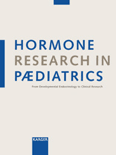
Hormone Research in Paediatrics
Exploring hormonal impacts on child development.Hormone Research in Paediatrics, published by KARGER, is a leading international journal dedicated to advancing the field of pediatric endocrinology. With its ISSN 1663-2818 and E-ISSN 1663-2826, it serves as a vital resource for researchers and professionals focused on the hormonal aspects affecting children's health. Housed in Switzerland, the journal benefits from a strong academic reputation and ranks in the prestigious Q1 category in Pediatrics, Perinatology, and Child Health, as well as maintaining Q2 status in Endocrinology, Diabetes, and Metabolism. Covering a time span from its inception in 1970 to the present day, Hormone Research in Paediatrics is committed to publishing high-quality original research, reviews, and clinical studies, making crucial contributions to our understanding of pediatric hormonal disorders and treatments. The journal incorporates open access options, fostering wider dissemination and accessibility of vital research findings, thus ensuring that significant advancements reach academics, professionals, and students globally.
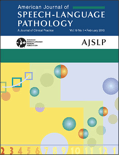
AMERICAN JOURNAL OF SPEECH-LANGUAGE PATHOLOGY
Transforming Lives with Cutting-Edge Speech-Language ResearchAMERICAN JOURNAL OF SPEECH-LANGUAGE PATHOLOGY is a premier publication in the fields of speech-language pathology, linguistics, and related health professions, published by the American Speech-Language-Hearing Association. With an impressive scope that encompasses research, clinical practice, and education, the journal aims to advance knowledge and practices in the diagnosis, treatment, and prevention of communication and swallowing disorders. It holds notable rankings in 2023, including Q2 in Developmental and Educational Psychology and Q1 across key categories such as Linguistics and Language, Medicine (Miscellaneous), Otorhinolaryngology, and Speech and Hearing, reflecting its significant impact and relevance in these domains. The journal’s robust methodology and peer-reviewed articles serve as an essential resource for researchers, practitioners, and students alike, fostering innovation and collaboration within the field. Published continuously since 1996, it provides a platform for disseminating groundbreaking research that influences clinical practices and educational strategies, enhancing the quality of care for individuals with speech and language challenges.

Canadian Journal of Speech-Language Pathology and Audiology
Exploring the frontiers of speech and hearing health.Canadian Journal of Speech-Language Pathology and Audiology is a leading open-access journal dedicated to advancing the knowledge and practice within the fields of speech-language pathology and audiology. Published by the Canadian Association of Speech-Language Pathologists and Audiologists, this journal has been a vital resource since its inception, contributing significantly to the dissemination of research findings, clinical insights, and evidence-based practices. With a commitment to open access since 2007, researchers, professionals, and students can freely access high-quality articles that explore various aspects of communication disorders and audiology. The journal's unique position fosters collaboration and innovation in the field, aimed at enhancing the effectiveness of interventions and improving patient outcomes. As a critical platform for ongoing dialogue and education, the Canadian Journal of Speech-Language Pathology and Audiology continues to play an influential role in shaping the future of speech and hearing sciences.
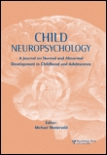
CHILD NEUROPSYCHOLOGY
Enhancing Clinical Practices through Groundbreaking ResearchCHILD NEUROPSYCHOLOGY, an esteemed journal published by Routledge Journals, Taylor & Francis Ltd, focuses on the intricate interplay between neurological and psychological development in children. With an ISSN of 0929-7049 and an E-ISSN of 1744-4136, this journal has been a pivotal resource in the field since 1995, catering to researchers, clinicians, and educators alike. The journal holds a prestigious position in the Q2 quartile across key categories such as Developmental and Educational Psychology, Neuropsychology and Physiological Psychology, and Pediatrics, Perinatology, and Child Health as of 2023. Ranking in the 74th percentile for Pediatrics and reflecting its significant contributions, CHILD NEUROPSYCHOLOGY aims to publish groundbreaking studies that expand understanding of neurodevelopmental disorders and inform clinical practices. While not open access, the journal ensures high-quality, peer-reviewed articles that are vital for advancing knowledge and improving outcomes in child health and education. As it continues to bridge the gap between research and practice, CHILD NEUROPSYCHOLOGY remains an essential resource for those dedicated to advancing the science of child cognitive and emotional development.
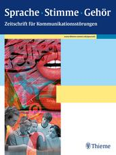
SPRACHE-STIMME-GEHOR
Bridging Knowledge Gaps in Applied Psychology and Speech Therapy.SPRACHE-STIMME-GEHOR is an esteemed academic journal published by GEORG THIEME VERLAG KG since 1980, focusing on the intersection of applied psychology, psychiatry, and speech and hearing. With an ISSN of 0342-0477 and E-ISSN 1439-1260, this journal serves as a vital resource for researchers, clinicians, and students dedicated to advancing knowledge and practice in these fields. Although currently not an open access journal, its rigorous peer-review process ensures the publication of high-quality research and clinical studies. In the 2023 Scopus ranking, it holds a position in the fourth quartile in relevant categories such as Applied Psychology and Speech and Hearing, illustrating its niche yet important role within the scientific community. The journal, based in Stuttgart, Germany, offers insights into innovative therapeutic approaches, evidence-based practice, and the latest trends, making it an essential read for professionals striving to enhance their understanding and impact in speech and hearing disciplines.

Communication Sciences and Disorders-CSD
Shaping the landscape of speech-language pathology research.Communication Sciences and Disorders-CSD, published by the Korean Academy of Speech-Language Pathology & Audiology, is a pivotal academic journal dedicated to the fields of communication sciences, speech-language pathology, and audiology. With an ISSN of 2288-1328 and an E-ISSN of 2288-0917, this journal has been contributing to the body of knowledge since 2013 and is set to continue its impactful journey through 2024. The journal is recognized for its rigorous research and maintains respectable rankings within various categories, achieving a Q2 in Linguistics and Language and Q3 in Communication, Speech, and Hearing for 2023. It offers valuable insights for researchers and professionals committed to advancing understanding and treatment in communication disorders. Though currently not open access, the journal provides robust academic resources that are essential for those striving to innovate and enhance practices in speech and hearing disciplines in South Korea and beyond.
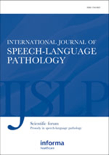
International Journal of Speech-Language Pathology
Guiding best practices in speech and hearing sciences.International Journal of Speech-Language Pathology is a prestigious peer-reviewed journal published by Taylor & Francis Ltd, dedicated to advancing the field of speech-language pathology through original research, systematic reviews, and innovative theoretical contributions. Since its inception in 1999, the journal serves as a critical resource for researchers, clinicians, and educators in linguistics, speech, and hearing sciences, boasting an impressive Q1 ranking in Linguistics and Language and strong standings across various related categories. With a 2023 Scopus rank indicating its significant impact—positioned in the top 10% of its field—the journal facilitates a platform for sharing impactful findings and clinical advancements, guiding best practices and policies in treatment and intervention. Although it is not an open access journal, the work published within its pages is often made accessible through various institutional resources, ensuring its reach to a broad academic audience. For those striving to stay at the forefront of speech-language pathology, this journal is an indispensable tool for enriching knowledge and enhancing professional practice.
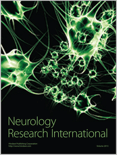
Neurology Research International
Elevating Knowledge in Neurological ScienceNeurology Research International, published by HINDAWI LTD, is an esteemed open access journal that has been serving the neurology community since 2010. With its ISSN 2090-1852 and E-ISSN 2090-1860, this journal aims to foster knowledge dissemination and facilitate dialogue surrounding key issues in neurology and clinical neuroscience, making it a vital resource for researchers, clinicians, and students alike. It operates from the United States, with its administrative hub located in London, England. As of 2023, the journal has been positioned in the Q3 category for both neurology and clinical neurology, reflecting its commitment to advancing research within these critical fields. With a current Scopus rank of #216/400 in clinical neurology and a #113/192 in neuroscience, and a converged publication timeline from 2010 to 2024, Neurology Research International is dedicated to promoting high-quality research that addresses contemporary challenges and innovations in neurological science. By offering open access since its inception, it ensures that cutting-edge research is freely available, aligning with the global push towards accessible scientific communication.

ANNALS OF DYSLEXIA
Unraveling the intricacies of language processing disorders.ANNALS OF DYSLEXIA is a prestigious academic journal published by SPRINGER, dedicated to advancing research in the fields of education and speech and hearing, particularly focusing on dyslexia and related language processing disorders. With its impactful insights, ANNALS OF DYSLEXIA holds a highly regarded position, boasting a Q1 category ranking in both education and speech and hearing as of 2023. The journal, which has been a vital resource since its inception in 1982, facilitates the dissemination of groundbreaking studies and innovative methodologies aimed at improving the understanding and intervention of dyslexia. Researchers and professionals in the field benefit from its comprehensive scope, supported by impressive Scopus rankings, including a top 10 position in Health Professions and a strong presence in Social Sciences. The journal provides a platform for practitioners, educators, and scholars to explore critical issues, share pragmatic solutions, and foster collaboration among interdisciplinary communities. As part of its commitment to the advancement of knowledge, ANNALS OF DYSLEXIA remains a cornerstone resource for those dedicated to enhancing educational outcomes for individuals with dyslexia.
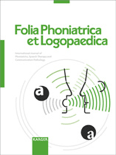
FOLIA PHONIATRICA ET LOGOPAEDICA
Elevating Standards in Communication Research and TherapyFOLIA PHONIATRICA ET LOGOPAEDICA, published by KARGER in Switzerland, stands as a premier journal in the fields of linguistics, phonetics, and speech therapy. With a rich history beginning in 1949 and spanning multiple decades, this esteemed journal has maintained a commitment to advancing research and scholarship in communication sciences, covering crucial topics relevant to both clinical practice and theoretical frameworks. Holding a prestigious Q1 ranking in Linguistics and Language, the journal also achieves high standings in related categories, with notable placements in Speech and Hearing and Nursing. Researchers, professionals, and students will find the insights and findings published within its pages to be invaluable for both academic pursuits and practical applications. Access options are available through traditional subscription models, enhancing its accessibility for dedicated scholars seeking to contribute to or expand their knowledge in this dynamic field.